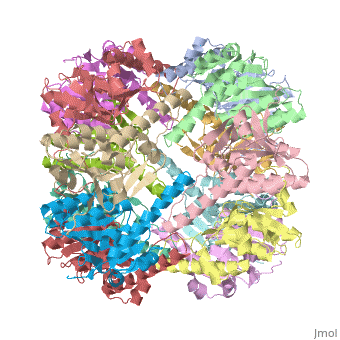Clp Protease: Difference between revisions
Michal Harel (talk | contribs) No edit summary |
Michal Harel (talk | contribs) No edit summary |
||
| Line 1: | Line 1: | ||
{{STRUCTURE_1tyf| PDB=1tyf | SIZE=400| SCENE= |right|CAPTION=Clp protease | {{STRUCTURE_1tyf| PDB=1tyf | SIZE=400| SCENE= |right|CAPTION=E. coli Clp protease, [[1tyf]] }} | ||
'''Clp protease''' (CLP) is a serine peptidase which hydrolyzes proteins in the presence of ATP and Mg+2 ion. CLP is found in mitochondria. CLP participates in degradation of misfolded proteins. CLP is a heterodimer containing an ATP-binding regulatory subunit A and catalytic subunit P. For more details see [[Clp protease]]. | '''Clp protease''' (CLP) is a serine peptidase which hydrolyzes proteins in the presence of ATP and Mg+2 ion. CLP is found in mitochondria. CLP participates in degradation of misfolded proteins. CLP is a heterodimer containing an ATP-binding regulatory subunit A and catalytic subunit P. For more details see [[Clp protease]]. | ||
Revision as of 12:21, 5 December 2013
| |||||||||
| E. coli Clp protease, 1tyf | |||||||||
|---|---|---|---|---|---|---|---|---|---|
| Activity: | Endopeptidase Clp, with EC number 3.4.21.92 | ||||||||
| |||||||||
| |||||||||
| Resources: | FirstGlance, OCA, PDBsum, RCSB | ||||||||
| Coordinates: | save as pdb, mmCIF, xml | ||||||||
Clp protease (CLP) is a serine peptidase which hydrolyzes proteins in the presence of ATP and Mg+2 ion. CLP is found in mitochondria. CLP participates in degradation of misfolded proteins. CLP is a heterodimer containing an ATP-binding regulatory subunit A and catalytic subunit P. For more details see Clp protease.
3D structures of Clp protease3D structures of Clp protease
Updated on 05-December-2013
CLP P subunitCLP P subunit
1tyf, 1yg6 – EcCLP – Escherichia coli
1yg8, 3hln - EcCLP (mutant)
1y7o – CLP – Streptococcus pneumoniae
1tg6 - CLP – human
2f6i, 4gm2, 4hnk - CLP – Plasmodium falciparum
2cby, 2ce3, 2c8t - CLP – Mycobacterium tuberculosis
3fes - CLP – Clostridium difficile
3ktg, 3kth, 3tt6 – BsCLP – Bacillus subtilis
3p2l - CLP – Francisella tulerensis
3q7h - CLP – Coxiella burnetii
3qwd, 3st9, 3sta, 3v5e, 4emm - SaCLP – Staphylococcus aureus
3v5i, 4emp - SaCLP (mutant)
2zl0 - HpCLP – Helicobacter pylori
2zl3 - HpCLP (mutant)
CLP P subunit binary complex
2fzs, 3mt6 - EcCLP + peptide
2zl2 - HpCLP + peptide
2zl4 - HpCLP (mutant) + peptide
3kti, 3ktj, 3ktk - BsCLP + peptide
3tt7 - BsCLP + DFP
CLP A subunitCLP A subunit
1k6k, 1r6c – EcCLP N terminal
1ovx - EcCLP N terminal - NMR
1ksf, 1r6b – EcCLP (mutant)
1um8 – HpCLP
CLP A subunit binary complex
1lzw, 1mg9, 1mbu, 1mbv, 1mbx – EcCLP + CLP adaptor protein ClpS
1r6o, 1r6q - EcCLP N terminal + CLP adaptor protein ClpS

